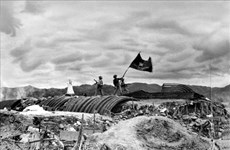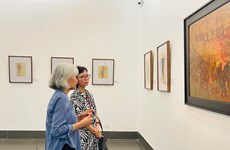Vietnamese lacquer paintings charm foreign tourists
Walking along Hanoi’s streets such as
Hang Khay and Hang Gai, it is common to see groups of foreign tourists
contemplating and buying souvenirs, many choosing lacquer paintings as
gifts for their relatives.
Walking along Hanoi’s streets such as
Hang Khay and Hang Gai, it is common to see groups of foreign tourists
contemplating and buying souvenirs, many choosing lacquer paintings as
gifts for their relatives.
“The first thing I do whenever I come to Vietnam is to go to the fine art and handicraft streets in Hanoi to seek out my favourite lacquer products,” said Keiko from Japan .
Vietnam’s unique painting techniques and materials give its lacquer paintings their special character, she said, adding that the type of paint that people use to make paintings is the most special among the world’s painting materials.
Many foreigners who love the paintings also want to learn how to make them. Despite being an amateur, after four months of studying, Liubov Fedovata, the wife of the Ukrainian Ambassador to Vietnam, was able to put on a small exhibition of her own lacquer paintings in her private house.
In 2008, she organised an individual show entitled “Ukrainian arts, inspiration from the colourful beauty of Vietnam” in Ho Chi Minh City.
Not just everyday people, but also many foreign artists are interested in the art of Vietnamese lacquer painting. In late 2009, young Vietnamese-American artist Phi Phi Oanh Nguyen put her lacquer paintings on show in Vietnam .
For Nguyen, who was born and raised in Houston, Texas, in the US, Vietnam is a foreign country, although she was brought up in a Vietnamese family. Before arriving in Vietnam to learn how to make lacquer paintings, she had to study the Vietnamese language.
After two years, with help from her Vietnamese friends, Nguyen completed her dazzling work, “Specula” – mirrors reflecting the specific architectural space of Hanoi through a lacquer painting drawn on the foundation of a curved dome.
In addition to lacquer paintings drawn on wood and iron foundations, the female artist also has a dream to restore the lacquer industry in Vietnam.
For German artist Ursula, her interest in the medium originated from lacquer paintings that her husband bought during his Vietnam visit 15 years ago. In 2005, the artist came to Vietnam to learn the technique.
To showcase this unique form of art before world friends, since 1993, the Hanoi University of Fine Arts has held a lacquer painting teaching class for foreigners. From several trainees at the beginning, the class now regularly attracts about 30 students every session.
Born in the 18th century, Vietnam ’s lacquer art has been continuously refined and developed, especially during the periods from 1945 to 1975 and between 1985 and 1990.
In addition to serving the domestic market, Vietnamese lacquer products have been exported to many other countries and won customers’ favour./.
“The first thing I do whenever I come to Vietnam is to go to the fine art and handicraft streets in Hanoi to seek out my favourite lacquer products,” said Keiko from Japan .
Vietnam’s unique painting techniques and materials give its lacquer paintings their special character, she said, adding that the type of paint that people use to make paintings is the most special among the world’s painting materials.
Many foreigners who love the paintings also want to learn how to make them. Despite being an amateur, after four months of studying, Liubov Fedovata, the wife of the Ukrainian Ambassador to Vietnam, was able to put on a small exhibition of her own lacquer paintings in her private house.
In 2008, she organised an individual show entitled “Ukrainian arts, inspiration from the colourful beauty of Vietnam” in Ho Chi Minh City.
Not just everyday people, but also many foreign artists are interested in the art of Vietnamese lacquer painting. In late 2009, young Vietnamese-American artist Phi Phi Oanh Nguyen put her lacquer paintings on show in Vietnam .
For Nguyen, who was born and raised in Houston, Texas, in the US, Vietnam is a foreign country, although she was brought up in a Vietnamese family. Before arriving in Vietnam to learn how to make lacquer paintings, she had to study the Vietnamese language.
After two years, with help from her Vietnamese friends, Nguyen completed her dazzling work, “Specula” – mirrors reflecting the specific architectural space of Hanoi through a lacquer painting drawn on the foundation of a curved dome.
In addition to lacquer paintings drawn on wood and iron foundations, the female artist also has a dream to restore the lacquer industry in Vietnam.
For German artist Ursula, her interest in the medium originated from lacquer paintings that her husband bought during his Vietnam visit 15 years ago. In 2005, the artist came to Vietnam to learn the technique.
To showcase this unique form of art before world friends, since 1993, the Hanoi University of Fine Arts has held a lacquer painting teaching class for foreigners. From several trainees at the beginning, the class now regularly attracts about 30 students every session.
Born in the 18th century, Vietnam ’s lacquer art has been continuously refined and developed, especially during the periods from 1945 to 1975 and between 1985 and 1990.
In addition to serving the domestic market, Vietnamese lacquer products have been exported to many other countries and won customers’ favour./.













